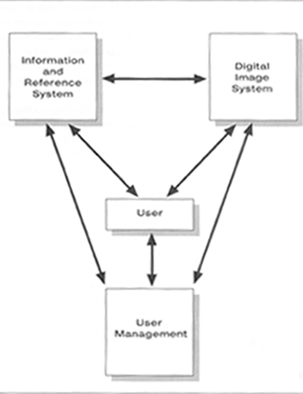The system was designed in modular form, based on the idea of distributed processing and client/server architecture. This was done to ensure flexibility for future use of the system in other larger or smaller archives, and took into consideration future access options through networks.

Figure 1. General Scheme of System Operation
Fundamental System Modules
From the user’s standpoint, the system consists of three modules, each of which covers a different group of functions:
The information and reference system provides descriptive information that gives the user all of the tools needed to find original or reproduced documents. It is not simply an index or database providing access to digitized information. It is a unified, global system of information valid for all descriptive information in the Archivo. It includes data contained in all the inventories, catalogs, and indices produced over the AGI’s history. It also includes the information necessary to recover digital images of the documents.
The digital image storage system offers the tools needed to consult digital copies on the monitor or on paper. The system handles two independent processes: document digitization and its storage on optical disk, and access to digitized images for consultation.
User management includes all of the functions relating to the retrieval of AGI documentation, through both manual and automated consultation:
- Tracking research requests (researchers’ files, topics of investigation, statistics on use, and user profiles)
- Monitoring Reading Room use
- Controlling document movement within the Archivo
- Controlling reproduction service for researchers
General Architecture
To handle the series of functions outlined above and to meet the aims for flexibility, the system consists of various subsystems. Each subsystem comprises a series of logically related functions that are carried out within their corresponding operating environments. Different servers provide the main functions in communication with the several workstations: These subsystems are as follows:
- The textual database deals with operation of the information and reference system. It includes the data entry and consultation processes.
- Digital image storage provides the resources for consultation of digital surrogates. It includes the processes of digitization and consultation.
- The user-management database permits control of the operation of archive and system consultation.
- The liaison interface provides the necessary communication with the other subsystems.
- The user interface facilitates user dialogue at the “client” station. It converts user inquiries into messages sent to the corresponding subsystem, and converts the messages received into easily intelligible replies.
- The printing subsystem allows for printing textual information and digital images.

